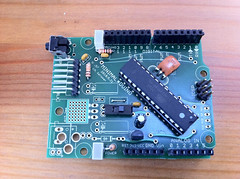(F)Light Suit Major Components
The main components of the (F)Light suit:
(Updated 8/15/11)

(Updated 8/15/11)
| Component(s) | Source | Status |
| LED strips | DealExtreme | 22 strips with connectors, need sealing and velcro backing. |
| 8-channel MOSFET Output Boards | DorkbotPDX board order | Three built and tested, work perfectly |
| Arm accelerometers | Modern Device | Left one on main board, right attached with 3-wire lead across shoulders |
| Black flight suit | Amazon | Needs velcro for LED strips |
| Arduino-compatible main board: Minimalduino 105 | DorkbotPDX board order | |
| Arduino interface board: Adafruit protoshield | Adafruit Industries | Done, ready for mounting and cable threading. Ports for MOSFET output boards, right accelerometer, remote control, audio sensor |
| Remote control | homemade, various parts | Needs laser-cut acrylic surround, rot 2 flaky |
| Batteries | eBay | 12V, 4800mAh Li-ion battery packs with barrel connectors, powering third MOSFET board. |
| Audio input: ZX-Sound board | RobotShop.com | Test, add light, change connector, paint, velcro back |
| Missing anything? |







